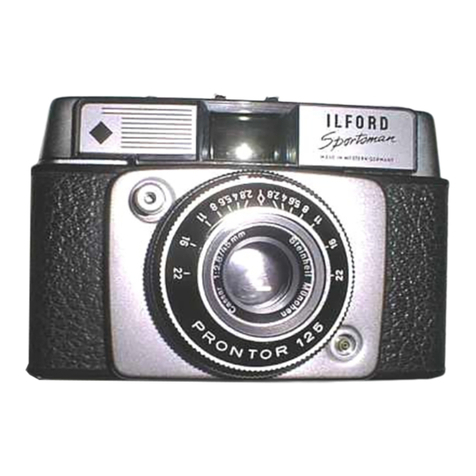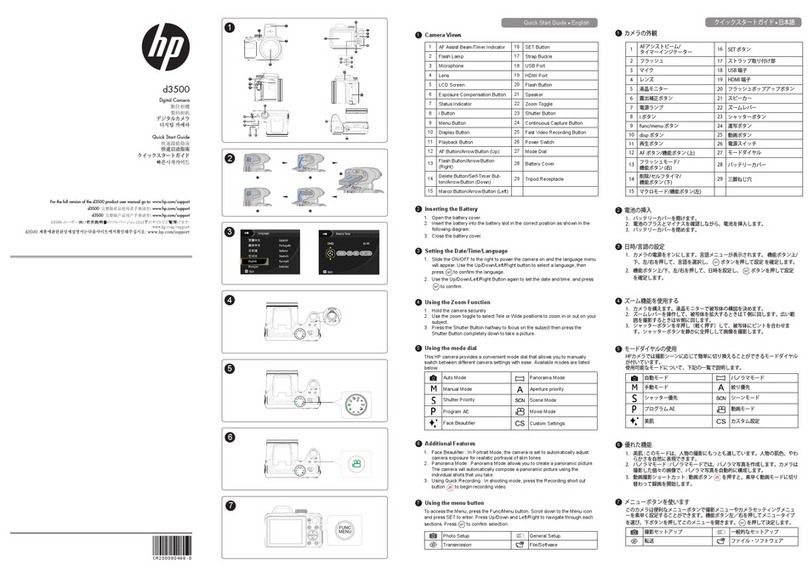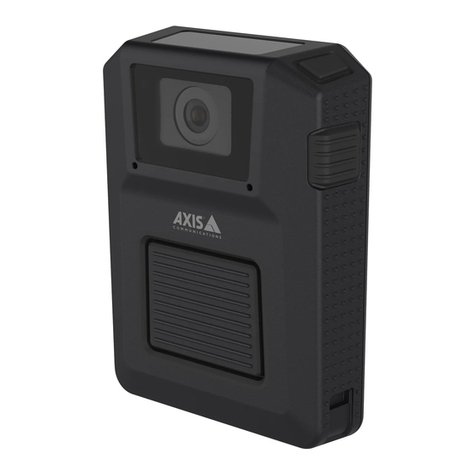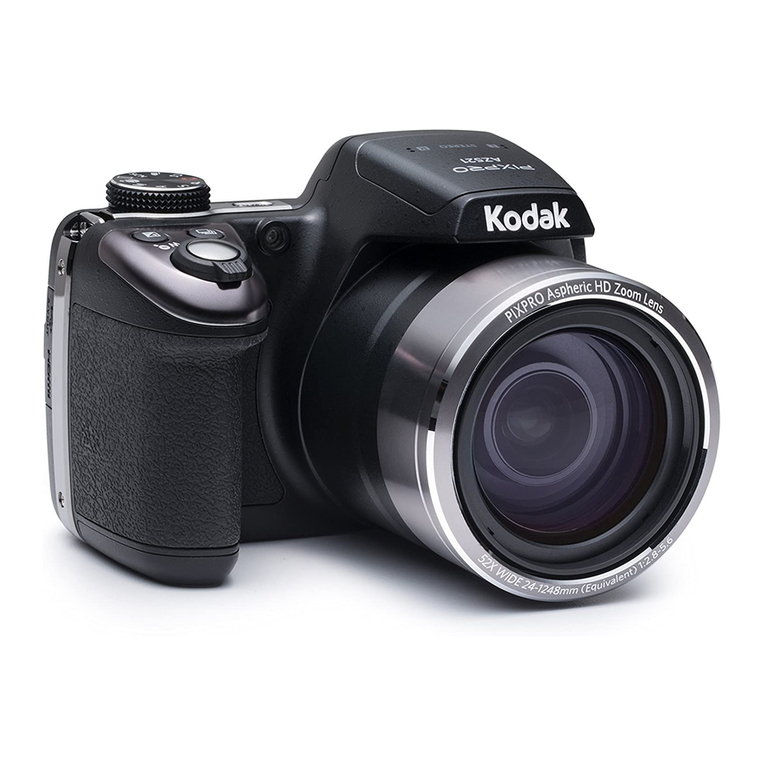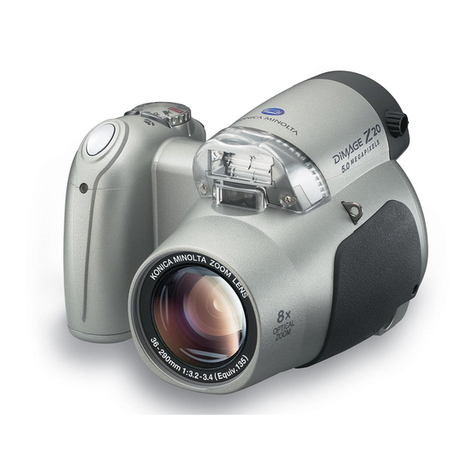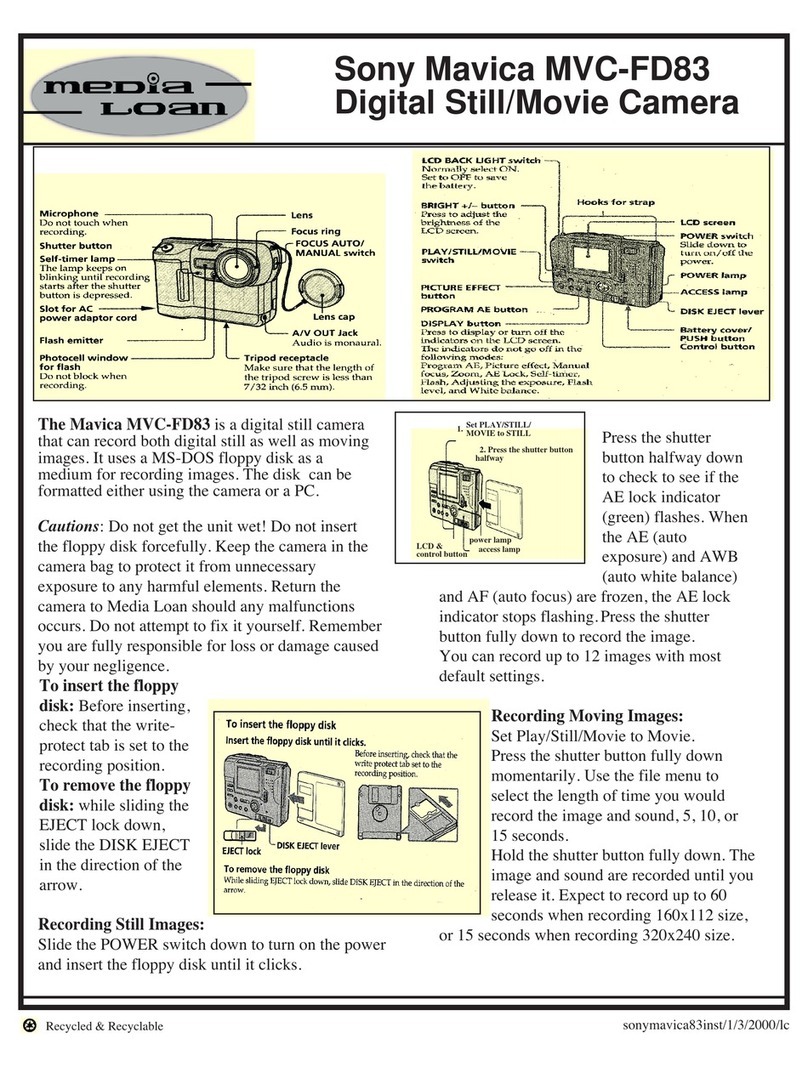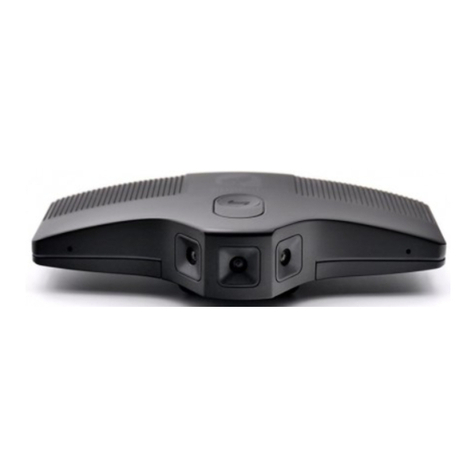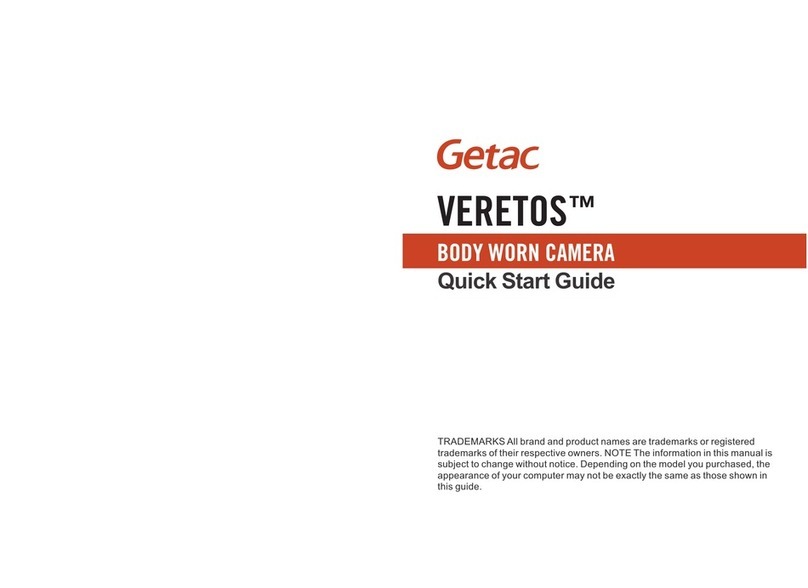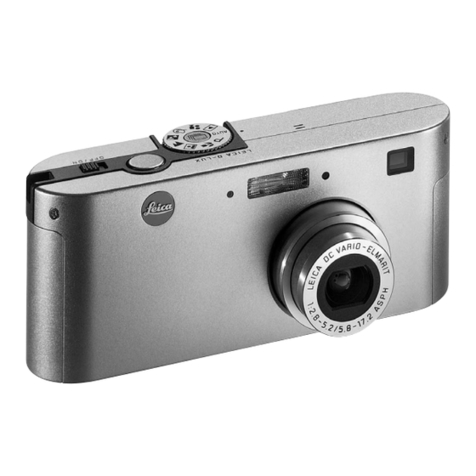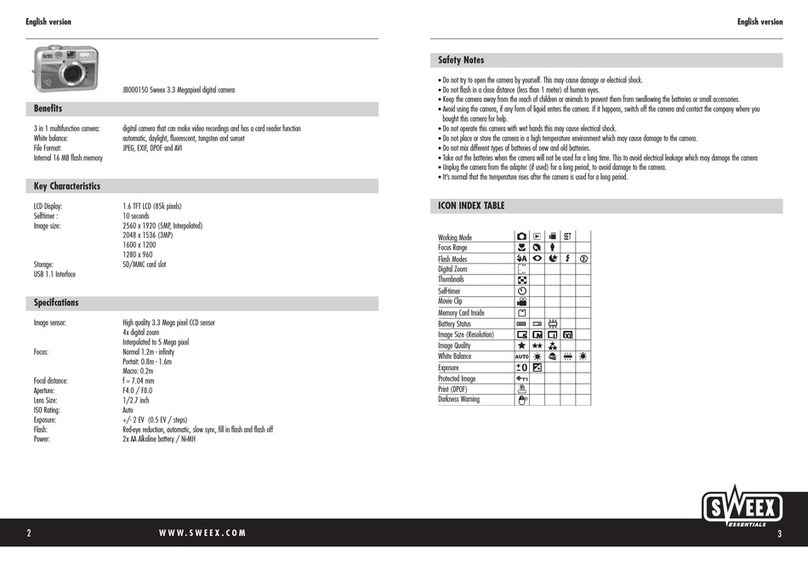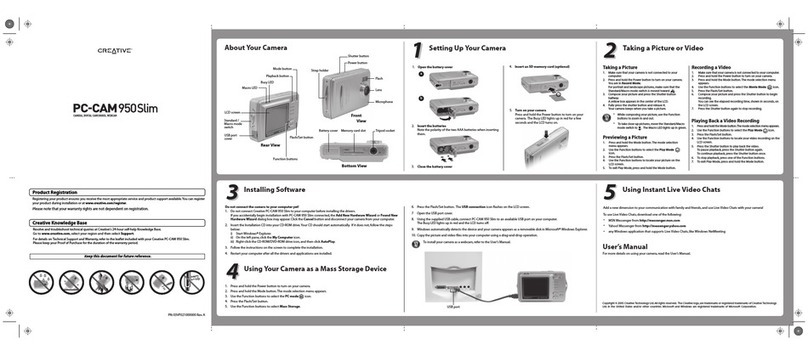Ilford Sportoman User manual


CAMERA
DETAILS
1.
2.
3.
4.
5.
6.
7.
8.
9.
10.
11.
12.
13.
14.
Film-speedreminderdisc
Locking
catch
Rewind
knob
Exposurecounter
Filmwindlever
Shutter
speed
settingring
Aperturesettinglever
Focusingring
3epth-of-field
scale
Viewfinder
Shutter
release
Rewind
releasebutton
Accessoryshoe
Flashcontact

ILFORD
Camera
The
Ilford
Sportsman
isa
soundly
mate
and
attractivelystyled
35mm.
miniature
camera
which
has
beendesigned
for
quick,easy
operation.
It
will
take
first-class
pictures
in
bothcolour
and
black-and-white.
Before
taking
any
pictureswithyour
Ilford
Sportsman,
be
sure
to
read
this
instructionbook
carefully
andto
practiseusing
the
camerawithout
film.In
thisway,
you
willquickly
lean,
tousethe
Sportsman
confidently
so
thatwhen
you
eventually
load
it
with
filmyou
will
be
quitecertain
of
getting
goodpicturesright
from
the
start.
EveryIlford
Sportsman
is
carefully
constructed,
thoroughly
tested
and
guaranteed
forone
year
from
the
date
of
purchase.
So
don't
forget
to
complete
the
guaranteeform
and
post
itto
IlfordLimited,Ilford,
Essex,
withoutdelay.
The
Ilford Sportsman,whichtakes
35mm.filmin
standardcassettes
and
gives
a
picturesize
of24x
36
mm.,
isfitted
with
a
rapid
film
windlever(5).
The
camera
is
equippedwith
a
three-element
anastigmat
lens,having
a
focal
length
of
45
mm.anda
maximumaperture
off/3^5.
The
lens
is
coated
and
givesexcellentresults
on
both
colou;
and
black-and-white
films.
A
singlemovement
ofthefilm
windlever
(5)
performsthree
operations;
the
filmis
advanced,
the
shutter
issetandthe
exposurecounter
is
adjusted
to
show
the
number
of
exposuresstillavailable.
Thefilm
wind
andthe
shutter
release
are
interlocked
so
that
double
exposures
arenot
normally
3

Opening
the
camera
Loading
the
camera

possible
andthefilm
cannot
be
wourni
on
without
an
exposurehaving
beenmade.
The
largeshutterreleasebutton
(11)
is
conveniently
placed
onthe
front
ofthe
camera
so
that
when
itis
gently
pressed
there
isno
risk
of
camera
shake.
The
centre
of
this
button
will
accept
a
cable
release.
The
Vario
shutter
has
threespeeds,
1/25,
1/50
and
1/200
sec.,
and
also
a
"B"
setting
for
brieftimeexposures.
The
shutter
is
synchronised
forflash
(14)
and
has
"X"
typesynchronisation.This
nvans
thatelectronic
flash
units
may
be
used
atall
shutterspeeds
and
'"lashbulbs
ata
shutterspeed
of
1/25
sec.
The
viewfinder
(10)
isofthe
optica'
direct-vision
type
andis
used
at
eye
level.
Thefinder
gives
a
brilliantimagewith
the
picture
area
shown
by
a
bright
line.
The
centre
of
the
picturearea
is
indicated
bya
cross.
Two
marks
atthe
side
ofthe
brightline
frame
indicate
thetopofthe
picture
areawhen
the
camera
is
beingused
for
close-uppictures
ata
distance
of
about
6
feet
or
closer.
A
similar
amount
will
alsoappear
inthe
negative
atthe
bottom
ofthe
picturealthough
this
isnot
marked
onthefinder.
OPENING
THE
CAMERA
The
back
ofthe
camera
is
opened
by
sliding
the
smallbutton
onthe
lockingcatch
(2)
towards
the
base
ofthe
camera.Thisbutton
isonthe
left-hand
side
ofthe
camera
asitis
held
ready
for
use.
LOADING
THE
CAMERA
The
camerashouldalways
be
loaded
and
unloaded
inthe
shade,
outof
direct
sunshine.After
the
camera
b;<~t
has
been
opened,
the
rewind
knob
(3)
should
be
pulled
outtothe
maximum
extent
andthe
cassette
of
film
placed
inthe
camera.
The
free
endofthefilm
whichprojects
from
the
cassetteshouldextendacross
thefilm
track
inthe
direction
ofthe
take-up
spool.Pushback
the
rewindknobgently
and
turnuntil
it
engages
-
with
the
core
ofthe
cassette.Thenoperate
the
lever
windonce,
butdo
not
release
the
shutter,
•

Setting
the
exposure
counter
Setting
the
film
speed
reminder disc

The
leading
endofthefilmcan
then
he
taken
across
the
film
track
and
slippedinto
the
slit
ofthe
take-upspool.
Ifthe
take-upspool
isnotin
the
correct
position
andthe
slitcannot
be
seen,
the
spool
canbe
rotated
with
the
thumb
onthe
lower
milled-edg:;
flange.
Makesurethat
the
small
projection
atthe
lower
endofthe
slit
inthe
take-upspool
is
engaging
a
perforation
inthefilm.
Nextturn
the
take-up
spoolwith
the
thumb
so
that
the
tongue
ofthe
film
winds
onto
it;
continuedoingthisuntil
the
full
widthpart
ofthefilm
is
justprotruding
from
the
mouth
ofte
cassette.
The
cameraback
can
then
be
closed.
Now
release
the
shutter
(11)
and
operate
thefilm
windlever
(5)
three
times.This
will
bring
the
thirdframe
onthe
full
widthpart
ofthefilm
into
position
and
clear
film
which
may
possiblyhavebeenfogged
in
loading.
The
camera
isnow
ready
to
take
thefirst
picture
by
pressing
the
shutterrelease.
The
rewindknob
(3)
shouldturnanti-clockwisewhen
thefilm
wind
is
operated
and
thisindicatesthat
thefilmis
passingthrough
the
camera
in
the
proper
way.
The
exposurecounter
(4)
should
next
besetto20or36,
depending
on
whether
a 20
exposure
or36
exposure
fassette
offilmwas
loaded.
The
exposurecounterindicates
the
number
of
exposuresremaining
inthe
cassette.
Thefilm-speed
reminderdisc
(1)onthetopofthe
rewindknob
should
lastly
besetto
indicate
the
type
offilminthe
camera.
EXPOSURE
AND
FOCUSINi
CONTROLS
The
lens
is
focused
by
rotating
the
focusing
ring
(8)
until
the
distance
of
the
principalsubject,measured
in
feet,
liesagainst
the
diamond-shaped
index
mark
onthe
front
plate
ofthe
shutter.
The
aperture
markings
on
eitherside
of
thisindexshow
the
zone
of
sharpnesswhichextends
on
eitherside
ofthe
focuseddistance,
a-;
different
lensapertures.
The
shutterspeed
issetby
rotating
the
milledouterring
(6)onthe
lens
panel
so
that
the
desiredshutterspeed,cither
1/25,1/50,
or
1/200
sec.,
lies

against
the
samewhiteindexmark
asis
used
forthe
focusing
scale.
The
"B"
setting
ofthe
shutter
is
used
for
brief
timeexposures
andthe
shutter
will
remain
open
so
long
asthe
shutter
release
button
is
held
depressed
or
pressure
is
maintained
onthe
cablerelease.
The
cameramust
be
mounted
ona
tripod
or
other
firm
supportwhen
the"B"
setting
is
used.
The
aperturesetting
is
controlled
bythe
smalllever
(7)
which
is
visible
onthetopofthe
lens
mounting,
the
knife-edge
ofthe
lever
isset
against
the
desiredlensaperturemarking.
TAKING
THE
PICTURE
After
the
lens
has
beenfocused,
the
shutterspeed
setandthe
correct
aperturechosen,
the
subject
is
viewedthrough
the
optical
viewfinder.
Hold
the
camera
firmly
withbothhands
and
thengentlysqueeze
the
shutter
release
with
the
forefinger
ofthe
right
hand.
When
using
a
shutter
speed
of
1/25
sec.,
take
upasfirma
stance
as
possible,
leaningagainst
a
solid
objectsuch
asa
wall,
or
somesimilarsupport.
In
setting
the
focusing
scale,
distances
upto12
feetshould
be
estimated
or
measuredaccurately,
but
greaterdistances
canbe
estimatedapproxi-
mately.
The
correct
aperture
and
shutter
speeds
canbe
estimated
from
the
exposure
tablesprovided
on
page
11
of
thisinstructionbooklet,
ora
photo-electric
or
other
exposure
meter
maybe
used.
After
the
exposure
has
beenmade,
thefilm-wind
levershould
be
opera-
ted
immediately
so
that
the
camera
isat
onceready
fora
furtherexposure.
The
lever
should
always
be
moved
firmlyand
smoothly
totheendof
its
travel.This
is
importantbecause
ifthe
full
movement
isnot
made,
the
shutterwill
notbesetandno
exposurewill
be
madewhen
the
shutter
release
is
pressed.
The
windlever
should
notbe
allowed
to
returnfreely
under
the
pressure
ofits
spring
but
should
be
controlled
bythe
thumb,
so
that
it
moves
back
smoothly
and
gently
toits
position
ready
forthe
nextoperation.
8

TAKING
OUTTHE
FILM
When
you
haveexposed
allthe20or36
exposures
onthefilm,it
must
be
completely
rewound
into
the
cassette
before
the
camera
back
is
opened.
Thefilmis
rewound
by
depressing
the
rewind
releasebutton
(12)
inthe
base-
plate
ofthe
camera
andatthe
sametimeturning
the
rewindknob
ina
clockwise
direction
as
shown
bythe
anow.
Rewindingshould
be
con-
tinued
with
the
rewindreleasebuttonhelddepresseduntil
thefilm
pulls
away
from
the
take-upspool.
Ifthefitewas
properlyattached
tothe
take-up
spoolwhen
the
camera
was
loaded,someresistance
will
be
felt
at
this
point.
When
thefilmhas
beencompletelyrewound
the
camera
back
canbe
opened
andthe
cassetteremoved
from
the
camera.
SNAPSHOT
SETTINGS
Onan
average
sunny
dayin
summer
and
with
a
medium-speed
film
such
as
IlfordFP3,
the
camera
canbesetso
that
itis
ready
foruseatall
times
without
further
adjustment.
The
apertureshould
beset
to/711
andthe
shutterspeed
to
1/50
sec.;
the
focusing
scaleshouldthen
besetto14
feet.
It
will
be
seenthat
the
depth
offie'd
extends
from
about
7
feet
to
infinity
andthe
Sportsman
canbe
usedsimply
asa
snapshot
camera.
FLASHSYNCHRONISATION
A
small
flashgun,
such
asthe
Ilford
Sportslite,
canbefitted
into
the
accessoryshoe(13)
onthetopofthe
cameraabove
the
viewflnder.
The
synchronisinglead
oftheflashgunfe
connected
tothe
camera
bythe
standard
3 mm.
contact
atthe
base
of
ihe
lenspanel.Makesurethat
the
connecter
is
pushed
firmly
home
before
using
the
camera.
The
Varie
shutter
has"X"
synchronisation
so
thateitherelectronic
flash
units
or
expendable
flashbulbsmay
be
used.Electronic
flash
units
may
be
used
atany
shutterspeed
from
1/25
sec.
to
1/200
sec.
and
expendable
flashbulbsata
shutterspeed
of
1/25sec.
9

CHOOSING
THE
RIGHT
FILM
The
IlfordSportsman
is so
simple
to use
thatcolourpictures
are
just
as
easy
to
take
as
black
and
white.Makesuccess
doubly
certain
by
using
Ilford
35mm.films,
which
are
made
ina
range
to
suiteverysubject
and
everyexposurecondition.
ILFORD
Colour
Film
D
The
ideal
filmfor
making
glowing
colourtransparencies
ofany
subject
by
daylight.
ILFORD
Colour
Film
F
The
colour
film
that
is
balanced
foruse
with
clear
flashbulbs.
ILFORD
PanF
The
almostgrainless,thin-emulsion
filmfor
negatives
of
unmatched
definition
and
enlarging
quality.
ILFORD
FP3
Thefine
grain
film
withbalancedcolourresponse
and
amplespeed
for
general
use.
ILFORD
HP3
The
high-speed
film
that
is
famous
forits
superball-roundperformance.
ILFORD
HPS
An
extremelyfast
film,for
successful
photography
byany
light.
10


ILFORD
•
ESSEX
Table of contents
Other Ilford Digital Camera manuals
